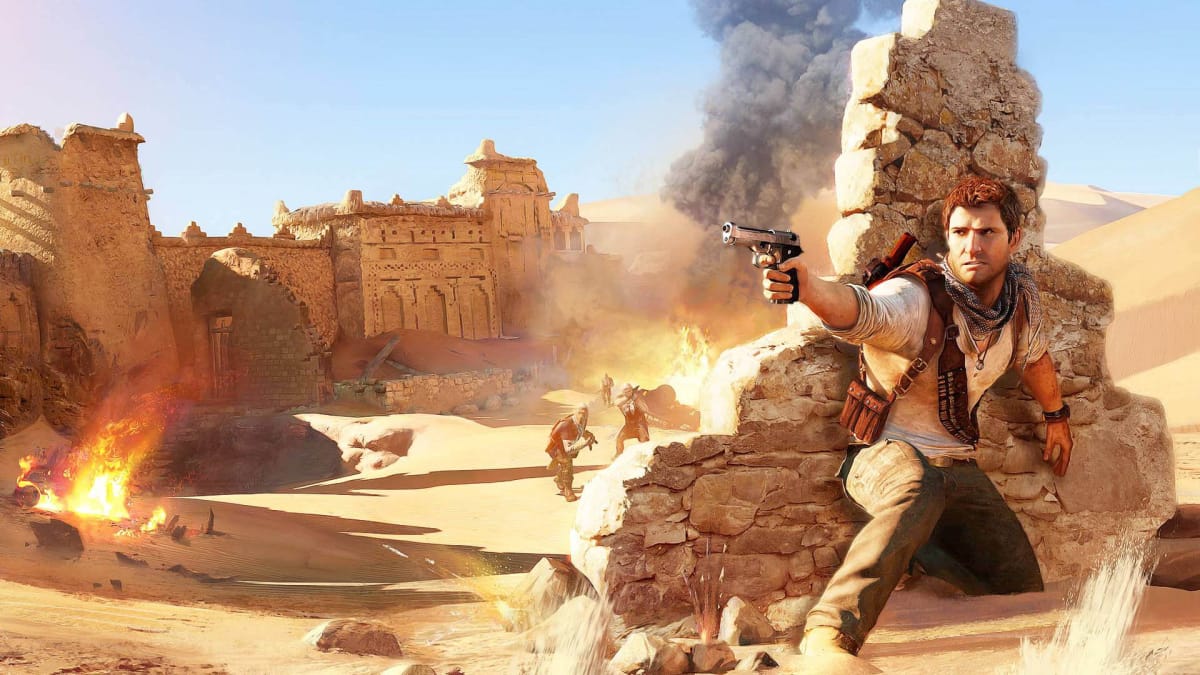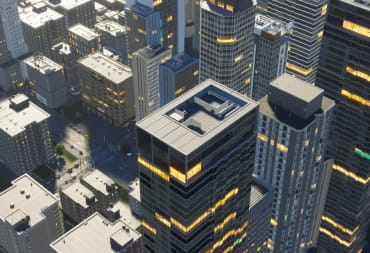As it stands, the mainline Uncharted quadrilogy is one of the most venerated adventure/third-person shooter series of all time. By marrying high production values with interactive set pieces, Naughty Dog helped amplify what a "cinematic game" meant during the seventh console generation. Uncharted 3: Drake's Deception initially seemed like the ultimate realization of that template, both to me and many others. But as that dopamine rush from well-framed action scenes and Drake's affable commentary wore off, an increasingly negative outlook soured the campaign for me. Considering how the story is among the few aspects left untouched, what with online server closures and gameplay tweaks in The Nathan Drake Collection, retrospectively analyzing its foundation could reveal better insights on the series’ successes altogether. When does it work? Was its precursor’s legacy a bedrock or quicksand for its own aspirations?
Warning: This piece contains spoilers for Uncharted 2 and 3.
Deception seems like a logical next step for the series. Nathan Drake and company face off against Marlowe’s cultish mob in search for The Iram of the Pillars (also known as "The Lost City of Ubar"). With a heavier thematic emphasis on legacy, a la Indiana Jones And The Last Crusade, and a structural similarity to Uncharted 2: Among Thieves, it seems like a nice blockbuster cuisine if cooked right.
Not Cooked Right

Something that linear titles like Uncharted have to nail is pacing. In lieu of giving players a panoply of mechanics and side quests, there's a heavier focus on balancing different gameplay scenarios with enough context to justify going from point A to point B. If the writing isn't well managed here, then player immersion can be lost. Half-Life 2 is one of the most cited examples of properly maintaining that disguise; neither narrative nor level design feel as though they interrupt the other. Although Naughty Dog admits to thinking up set pieces and tailoring the story and gameplay around them, earlier entries didn't seem as flagrant by comparison.
Looking at the wider arc shows just how dizzying this globe-trotting adventure becomes. Imagine you hadn't played Deception yet and I only divulged every locale in a leak: an English pub, part of the London Underground, Columbia (flashback missions), jungle chateau in France, Syria, Yemen, a grand cruise ship in The Gulf of Aden, and on and on. Like me, you’d appreciate Naughty Dog gleefully spinning a globe, stopping it with their finger, and saying, "We have to go here!" as though they couldn’t stop dreaming up new locations for their genuinely creative scenarios (even the upcoming movie directly lifts the plane sequence).
That excitement is misplaced when the undercooked writing makes the journey feel so loosely connected. The most flagrant example is the pirate Rameses' plot cul-de-sac. From the ship graveyard to the explosive cruise finale, one of the most technologically ambitious sequences coded on PS3 hardware is really just an eye-catching footnote. Compare the natural buildup in Uncharted's previous set pieces to the drastic change in atmosphere and critical antagonist here. What's accomplished in lying about Sully's capture and then ditching Drake back at the ship graveyard? How does this specific ruse, especially the way it's done, really get you ahead on finding The Lost City? Naturally, it's capped off with a preposterous deus ex machina where Drake miraculously winds up back on Yemen's shore and eventually onto Chloe's lap so the A plot can finally proceed.
The Precursor's Legacy

Even with some divergences and more locations than its predecessor, it's crazy just how often these writers lift from their old notes. Tell me if this sounds familiar to you:
- The playable opening segment that prompts a flashback.
- Nate and Sully net their first clue in a jungle area. Shortly thereafter, they're ambushed and forced to make a desperate escape.
- Previous party members decide this one is too much for them and leave.
- The new trio unearth their next big clue underneath an archeologically important city; shortly thereafter, they're ambushed by more henchmen and Drake meets his opponent(s) face to face.
- Nathan and Elena sneak into a depot which leads to him leaping from a Jeep onto a larger vehicle that's about to leave.
- Fighting ensues on this vehicle, eventually leading to its destruction.
- He's now facing the natural elements as well as a small contingent of henchmen before he's rescued by a native/several natives.
- After recovering for a spell, he's forced to fight enemies and jump between a convoy of trucks en route to The Lost City.
- The heart of The Lost City reveals the terrible truth about its demise and how The Special Item will be utilized by the villains.
- The heroes crash this party and have to escape this place as it's crumbling around them.
- Nate and Elena appear to be back together again.
Obviously it's not a 1:1 comparison, but the abundant similarities made it easy to predict almost every beat.
What's more annoying about this isn't the new ideas that don't work (Rameses B plot), but rather the recycled ones that are less effective. Consider the events during and after the plane's destruction. Again, it's another awe-inspiring set piece that feels like a cool follow-up of Among Thieves' train sequence. But the context for Drake's survival here goes past the suspension of disbelief by comparison. Nearly dying of thirst in the desert, with the only water source we visibly see him try is "undrinkable," doesn't mean you have enough adrenaline to fight off several squads. Coming from someone who's personally dealt with dehydration while working in attics before, this part felt so ridiculous - even by adventure serial standards. Even worse, all he seemingly needs is a good night's rest until he's back on Marlowe's trail.
Among Thieves handles this so much better. Although Drake's in a precarious situation and has to fight a few mercenaries, it only strains disbelief rather than break it. After surviving the tundra, it’s clear Drake’s still hurt from these events; the resulting gameplay has the player exploring a safe environment before acclimatizing back into the action with a whole chapter focused on easygoing platforming, puzzling, and one brief combat scenario. It was an effective way of reinforcing Drake’s debilitation through gameplay following the intense events that nearly got him killed. The plot didn't demand Drake rush ahead either since Lasarevic’s army lost their fastest option to catch up to him. All of those story and gameplay pacing cogs move in unison.
Confused Villainy

To preface this: I still respect what Uncharted 3's Creative Director/Lead Writer Amy Hennig was trying to do with the villainous duo. Having Marlowe be this self-described "cerebral" villain whilst Talbot would act as Drake's athletic match inferred a move away from cliched archetypes. The problem is both lack any clear vision.
To start with Marlowe: Her role as either direct or indirect threat stood on shifting sand (take a shot). Her henchmen have clear approval to kill Drake on sight whenever he's disrupting plans, yet she’s enraged when Cutter supposedly kills him and Sully in the beginning. Her stated reasoning was because it was "sloppy," but as opposed to what? She's willing to sit down and intimidate Drake after securing the necklace at the midway point, but leaves this loose end with an untrustworthy pirate? Let's compare that with Among Thieves. The first meeting with Lazarevic ends with him executing an unarmed, injured man. In just one scene you know this guy doesn’t joke around.
Talbot is a mess the more you think about him. Initially, he seemed like a cool lieutenant to Marlowe with a clever disappearing act. Those tricks are part of the problem. Between his ability to know Drake's exact whereabouts, oftentimes teleporting in and out of them, this cult he's in, shooting Cutter with a brainwashing dart, and the Tarot Card symbolism in the background, you'd figure he's a supernatural entity. Perhaps he only has a fraction of his power and he's donned this flesh suit to assist Marlowe in discovering Iram for his own ends. Even his viciousness during the final fight, like shaking off a direct gunshot wound (in a cutscene), suggests Naughty Dog was bouncing this idea around.
Judging by the plethora of confused players which prompted a response by Hennig, I'm not alone in saying Talbot wasn't properly utilized. Her official explanation comes back to Talbot being this cross between spec ops and magician, but this still falls flat to me. It's weird to keep him grounded in this way where he's an effective marksman but has a penchant for theatrical showmanship too. It feels so confused with respect to motivation and numerous plot holes. Plus, it's poor writing if extra elaboration outside of the game proper is required to understand his abilities.
Story In The Passenger Seat

Although Talbot is still included in these criticisms, the focus is more on how Naughty Dog's design didn't properly handle him either.
Deception's Lead Programmer Travis McIntosh expatiated on Naughty Dog’s damning mindset with an example: the intricate chase scene between Drake and Talbot. Why does Talbot, an established fighter and trickster, think it's productive to run away from his cadre just because Drake flips a table and gives chase? In McIntosh's own words, they had been developing this detailed chase level for one-and-a-quarter years without knowing who Nate would be chasing yet. So, they had to pluck the best candidate. This mindset worms its way into many story moments, compromising motivations and consistency in obsequious service to the action.
For old time’s sake, let's compare the final boss fight with Talbot to Lazarevic. To be honest, I wasn't a huge fan of this finale because the looser run-n-gun template didn't mesh well with the shooting mechanics; that said, I still greatly appreciate its purpose. After getting used to the power fantasy of cover-based shooting, it's refreshing to see Drake in the defensive position against a near-impervious warlord. The gameplay framework is perfectly contextualized as a wits vs. brawn battle with miraculous blue resin serving to be Lazarevic’s new source of strength and his ultimate downfall. Talbot's fight mirrors the other fistfights Drake had with that beefy henchman, but with a couple of new fight animations and Sully sporadically helping. Aside from the visual splendor of this crumbling city, there's no satisfying setup and payoff.
Creative Shackles

As much as I've critiqued Deception's writing, I don't want to put off that it's all bad. For starters, one aspect where Hennig's focus enhances the series’ legacy is the strengthened relationship between Nate and Sully. The greater emphasis on flashbacks turns the wise-cracking, cigar-chomping sidekick into an adoptive father figure. His moments of admonition carry more emotional weight as a result. I also thought this had some of Hennig's best quippy lines, thanks in part to the addition of Cutter. There are still fine qualities to appreciate here.
Now that 10 years have come and gone though, I believe history doesn't look as favorably on Uncharted 3 as its amassed GOTY and writing awards would suggest. Although I would’ve put it more facetiously in the past, my main critique remains the same: a story I don’t believe should’ve netted writing commemorations was headed by someone I absolutely believe deserves her lifetime awards. And when considering how Hennig’s preliminary work guided Uncharted 4: A Thief’s End, at least her last hurrah built upon the creative ambitions she began building here.
So, what is the main takeaway here? In essence, creatives would benefit from carefully considering the effectiveness of their past successes. Like a ledge Nate desperately grabs onto, it’s incredibly precarious to rely on previous work when you have disparate thematic goals.
Have a tip, or want to point out something we missed? Leave a Comment or e-mail us at tips@techraptor.net






